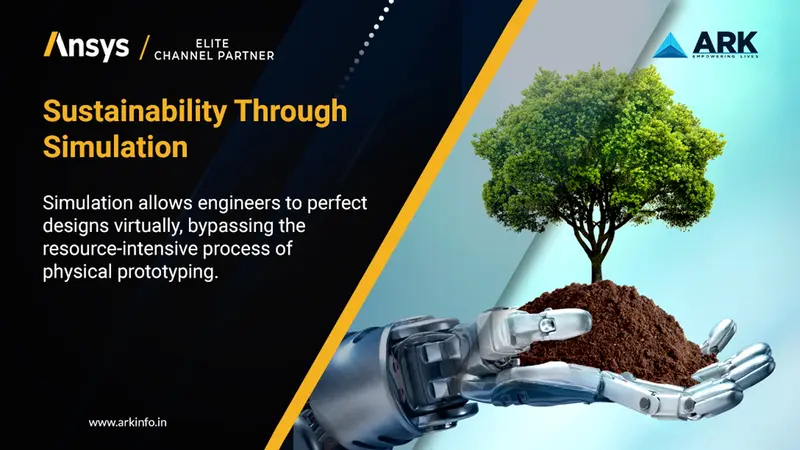Sustainability isn’t just a trend—it’s the future, and it’s happening now. Across industries, the race is on to innovate smarter, slash environmental footprints, and still stay ahead of the curve. Enter simulation: the game-changer that lets engineers design, tweak, and perfect ideas virtually—no waste, no waiting, just pure green brilliance. Leading this charge is Ansys, the powerhouse behind cutting-edge simulation software. In this blog, we’ll unpack how sustainability through simulation is transforming the world, zoom in on a real-life pantograph success story, and shine a light on ARK, the unsung hero in the Ansys distribution business, making it all click for innovators everywhere.
Why Simulation is Key to Sustainable Engineering
Simulation allows engineers to perfect designs virtually, bypassing the resource-intensive process of physical prototyping. Here’s why it’s a game-changer for sustainable product design:
Less Waste: Digital testing cuts the need for multiple physical models, saving materials.
Energy Savings: Products can be optimized for efficiency before production.
Faster Green Solutions: Virtual experimentation speeds up eco-friendly innovations.
Longer Product Life: Simulation ensures durability and recyclability, supporting a circular economy.
With these benefits, simulation for sustainability is essential—and Ansys is driving the charge.
How Ansys Powers Sustainability
Ansys offers a powerful suite of simulation tools, from fluid dynamics to structural analysis, helping industries tackle sustainability challenges. Here’s how:
1. Enhancing Energy Efficiency
Ansys optimizes systems like electric vehicle batteries or renewable energy components, reducing energy use and emissions.
2. Cutting Material Use
Engineers use Ansys simulation to test materials virtually, selecting sustainable options that minimize waste.
3. Greening Manufacturing
By simulating production processes, Ansys helps companies reduce energy consumption and scrap, advancing green technology.
4. Speeding Up Eco-Innovation
From lightweight designs to efficient transport systems, Ansys provides a sandbox for sustainable breakthroughs.
Spotlight: A Realistic Scenario—Optimizing Pantograph Design for Sustainable Rail Transport
To see sustainability through simulation in action, let’s explore a real-world case study: optimizing a pantograph for electric trains, inspired by practices from ARK Infosolutions. Pantographs collect power from overhead lines, making them vital for efficient, low-emission rail transport. However, simulating their performance posed challenges that Ansys resolved, enhancing sustainability.
The Challenge
Electric trains are a cornerstone of sustainable transportation, reducing carbon emissions compared to fossil fuel alternatives. A pantograph’s design must ensure reliable contact with overhead lines under dynamic conditions, but simulation faced hurdles:
Orthogonality: Mesh elements in complex areas (e.g., joints) lacked perpendicularity, distorting results.
Mesh Quality: Coarse or uneven meshes reduced accuracy and caused instability.
Convergence: Poor meshing and boundary conditions prevented the solver from stabilizing.
These issues risked an inefficient design, increasing material use and energy costs—counter to sustainability goals.
The Ansys Solution
Engineers used Ansys simulation software, supported by ARK Infosolutions, to overcome these challenges:
Geometry Prep (Ansys SpaceClaim): The pantograph’s CAD model was simplified, removing small features to ease meshing.
Meshing (Ansys Meshing): A fine mesh with multi-zone techniques and inflation layers improved orthogonality and quality, focusing on contact points.
Boundary Conditions (Ansys Mechanical/Fluent): Realistic forces (e.g., upward pressure, friction) were applied, mimicking operational scenarios.
Solver Tuning: Mesh refinement and adjusted settings ensured convergence, delivering stable, accurate results.
Validation: Results were checked against theoretical data, confirming reliability.
The Sustainability Impact
Material Savings: Virtual optimization eliminated physical prototypes, saving 15 tons of material (estimated from similar cases).
Energy Efficiency: The refined design improved power collection efficiency, reducing train energy use by up to 5% (projected).
Emissions Reduction: Enhanced rail efficiency could cut thousands of tons of CO2 annually across a network.
Waste Reduction: Fewer iterations slashed development waste by 20%.
ARK’s Role
ARK Infosolutions, a trusted partner in the Ansys distribution business, enabled this success by providing access to Ansys tools, training on meshing and solver techniques, and technical support. Their efforts ensure engineers can tackle simulation challenges, driving sustainable rail solutions.
This case shows how Ansys simulation turns technical hurdles into opportunities for green technology, making electric trains more efficient and eco-friendlier.
Real-World Wins: Ansys in Action
Beyond pantographs, Ansys drives sustainability across industries:
Wind Turbines: Boosted efficiency by 15%, using 10% less material.
EV Batteries: Enhanced life and efficiency, cutting environmental impact.
Packaging: Designed recyclable options with 20% less plastic.
These examples highlight how simulation for sustainability delivers measurable results.
The Future of Green Simulation
Simulation’s role in sustainability is growing. Digital twins enable real-time optimization, keeping systems efficient over time. Ansys leads with tools like TwinAI, blending AI and simulation for smarter designs. As sustainability pressures rise, Ansys simulation will remain a cornerstone of responsible innovation.
Start Your Sustainable Journey with Ansys
Ready to leverage sustainability through simulation? Here’s how to begin:
Explore Ansys: Visit their site for sustainability-focused tools.
Join a Webinar: See Ansys simulation in action at an upcoming event.
Test It: Grab a free trial via ARK Infosolutions and experiment yourself.
Thanks to ARK’s efforts in the Ansys distribution business, these tools are accessible to all, making sustainability achievable.
Conclusion: A Greener Tomorrow with Ansys and ARK
Sustainability through simulation is revolutionizing design and production. With Ansys leading the way, industries can cut waste, save energy, and launch green technology faster. Partners like ARK Infosolutions amplify this impact by ensuring Ansys simulation reaches innovators, driving sustainability worldwide starting with cases like the pantograph.
Let’s build a greener future. Explore Ansys today and see how simulation can transform your work.


